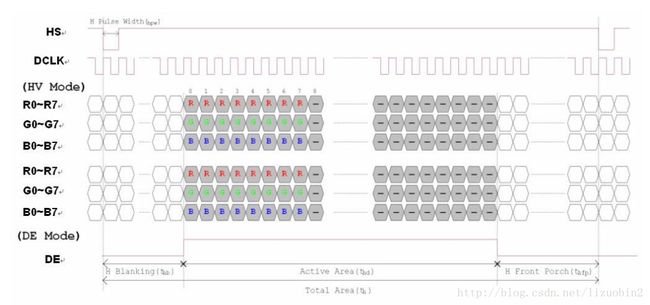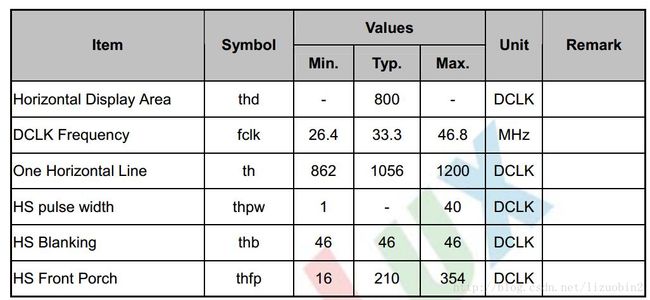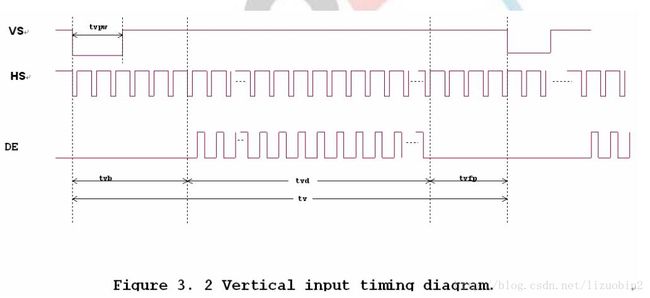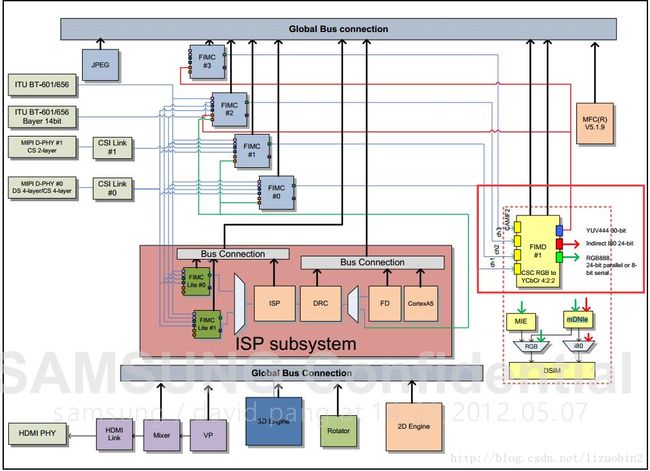设备树学习之(十二)LCD驱动
开发板:tiny4412SDK + S702 + 4GB Flash
要移植的内核版本:Linux-4.4.0 (支持device tree)
u-boot版本:友善之臂自带的 U-Boot 2010.12
busybox版本:busybox 1.25
参考:tiny4412LCD驱动加字符显示
1、背光
友善之臂的该款LCD采用了一线触控技术,包括背光控制也集成在一线触控之中,关于背光的控制,在前一篇文章中已经提及,本文重点在于LCD驱动。
2、LCD接口
- 1)Tiny 4412 使用的lcd接口为LCD1
- 2)图片数据信号接口
- B[0:7] : 蓝色数据信号线
- G[0:7] : 绿色数据信号线
- R[0:7] : 红色数据信号线
- 3)时序信号接口
- DEN 数据允许信号
- VSYNC 垂直同步信号
- HSYNC 水平同步信号
- VLCK LCD时钟信号
- 4)一线触控
- XEINT10_OUT
3、图像的构成
- 帧:一幅图像被称为一帧,每帧有多行组成,每行有多个像素点组成
- 像素:
- 1)显示的最小单位
- 2)由若干位的颜色数据来构成,像素越高,则一个像素点所需要的颜色数据越多,能够显示的颜色更广
- 3)一个像素点构成的颜色位数称为像素深度,单位为1BPP 常见的有16BPP/24BPP
4、颜色的量化(颜色<—–>数字)
颜色一般采用RGB标准,通过对红(R)、绿(GREEN),蓝(B)三个颜色以及相互叠加获取各种不同的颜色
- 1)通过对颜色的编码来对颜色进行量化(即转换成数字量,RGB是一种编码方式)
- 2)每种颜色根据RGB格式不同,每种颜色的量化位不相同
- 3) 常见的RGB格式有RGB565/RGB888
- RGB565: red :5 green : 6 blue:5
- RGB888: red :8 green : 8 blue:8
5、显示图像与LCD时序
- 1)使用HSYNC信号来控制一行的显示
- 2)使用VSYNC信号来控制一帧的显示
- 3)使用VCLK信号来控制一个像素的显示
- 4)使用VDEN信号来控制数据的输出
6、Exyons 4412 display 控制器
- 1)alpha,alpha操作用于实现图形渐变效果,以及半透明效果
- 0xfff == 全透明
- 0x0 == 不透明
- 2)colorkey,colorkey操作在融合两个窗口时过虑掉其中一个窗口的某一种特定颜色
- 3)HOZVAL与LINEVAL
- HOZVAL = (Horizontal display size) - 1
- LINEVAL = (Vertical display size) - 1
- 4)LCD时序图
notes:
.Using the display controller data, you can select one of the above data paths by setting LCDBLK_CFG Register(0x1001_0210). For more information, refer to the “System Others” manual





7、Exyons 4412 display 控制器配置
- 1)gpio配置,查看原理图 ,获取LCD接口的对应的gpio
- LCD_HSYNC:GPF0_0
- LCD_VSYNC:GPF0_1
- LCD_VDEV: GPF0_2
- LCD_VCLK: GPF0_3
- VD[23:0]:GPF1_0 - GPF1_5 / GPF2_0 - GPF2_7 / GPF3_0 - GPF3_3
- 2)时钟配置
- (1)查看Exyons 4412 手册 获取LCD时钟源
LCD 时钟源为SCLKmpll_user_t:800Mhz - (2)配置相关的寄存器得到LCD所需要的时钟 (见07lcd_clock)
- (1)查看Exyons 4412 手册 获取LCD时钟源
- 3)系统配置
LCDBLK_CFG : 配置成FIMD接口

一、设备树
&pinctrl_0 {
lcd_demo: lcd{
samsung,pins = "gpf0-0", "gpf0-1", "gpf0-2", "gpf0-3", "gpf0-4", "gpf0-5", "gpf0-6","gpf0-7", "gpf1-0", "gpf1-1", "gpf1-2", "gpf1-3", "gpf1-4", "gpf1-5", "gpf1-6","gpf1-7", "gpf2-0", "gpf2-1", "gpf2-2", "gpf2-3", "gpf2-4", "gpf2-5", "gpf2-6","gpf2-7", "gpf3-0", "gpf3-1", "gpf3-2", "gpf3-3";
samsung,pin-function = <2>;
samsung,pin-pud = <0>;
samsung,pin-drv = <0>;
};
};
lcd_demo@11C00000{
compatible = "tiny4412,lcd_demo";
reg = <0x11C00000 0x20c0 0x10010210 0x08 0x10023c80 0x04 0x1003c000 0x1000>;
pinctrl-names = "default";
pinctrl-0 = <&lcd_demo>;
clocks = <&clock CLK_FIMD0 &clock CLK_ACLK160>;
clock-names = "fimd0","aclk160";
};
二、驱动代码
#include 